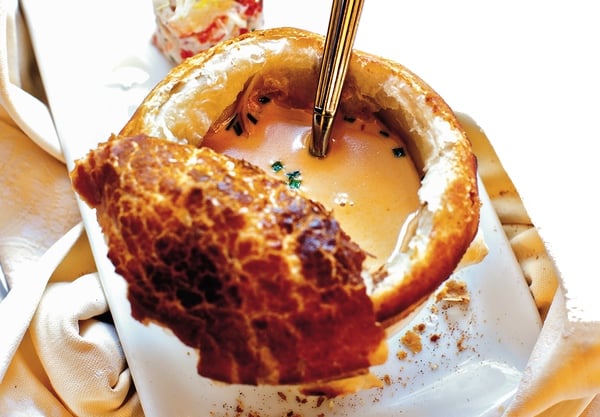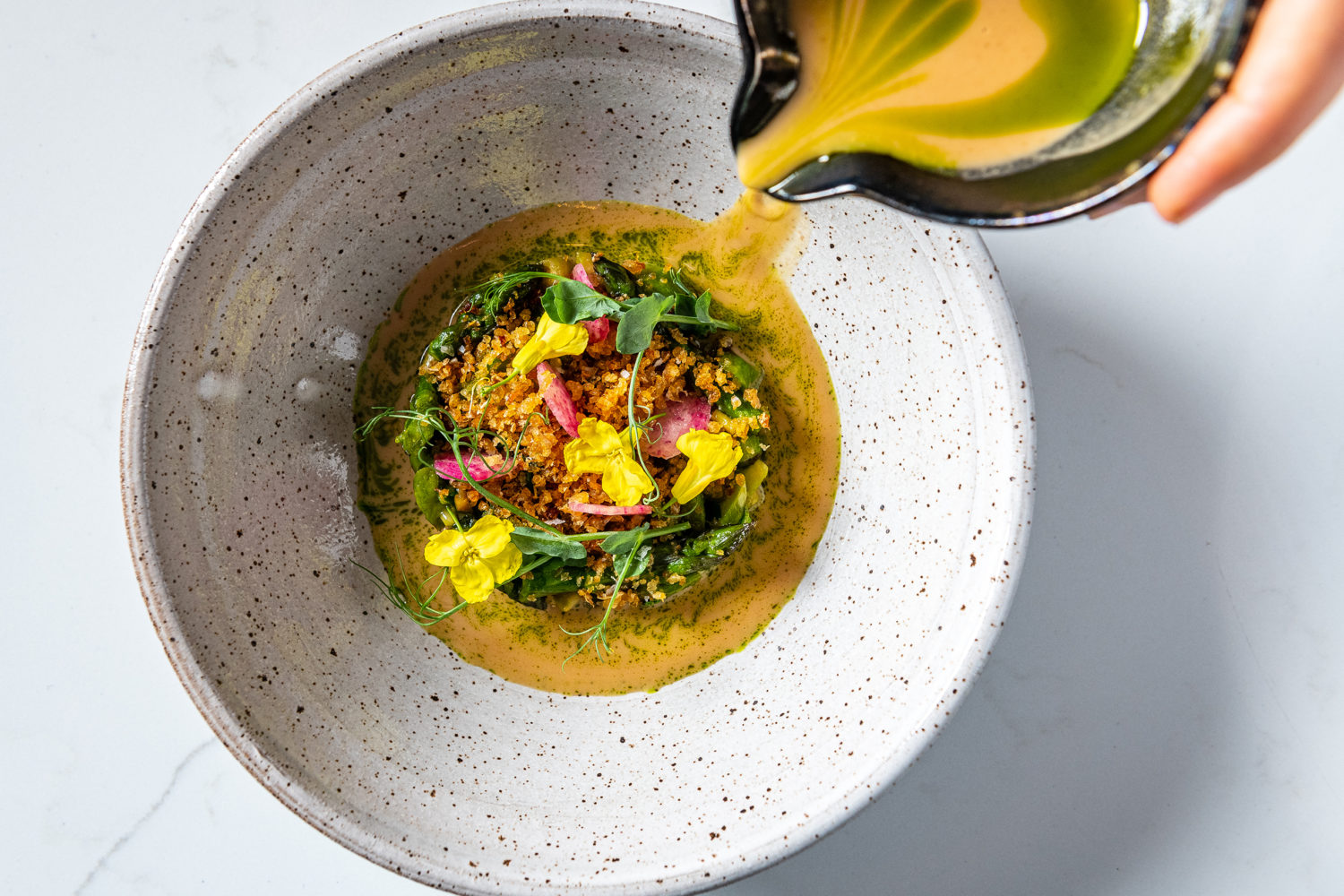
Meatballs are a tradition in chef Nick Stefanelli’s Italian family. On Sundays, his father made “Sunday gravy”—meatballs and sausages cooked in tomato sauce—or his aunts concocted their own recipes. At home, the family serves the same tomato sauce tossed with pasta for one course, and the meatballs for another. At Bibiana, Stefanelli showcases his own version: Veal meatballs cooked in sugo finto, a ragu of vegetables, water, and tomato paste that translates to “fake sauce” in Italian because it traditionally lacks meat. The dish is finished with creamy polenta and given a quick turn in the restaurant’s stone hearth for what Stefanelli calls “bubbly, cheesy polenta goodness.”
While the recipe is straightforward, Stefanelli recommends taking time with each step. He advises first-timers to fry the meatballs in batches so that the veal browns thoroughly and the caramelized drippings don’t burn in the bottom of the pan. If the sauce is too thin at the end, take the meatballs out and reduce the sauce slowly—otherwise, you’ll overcook the meat (you want the meatballs tender but not falling apart like in a braise). He also recommends cooking the meatballs a day or two before you plan to serve them. You won’t feel rushed, the flavors will have time to meld, and you can easily skim the solidified fat from the top of the dish.
Like the Stefanelli family, you can adapt the meatball recipe in many ways. Stefanelli says to try broth or stock instead of water for a richer sauce. As for the meatballs, you can serve them over pasta or tucked into a sandwich. Or better yet, make a large batch and try both variations with the leftovers.
Have a recipe you'd like sniffed out? E-mail recipesleuth@washingtonian.com.
Bibiana’s Veal Meatballs With Polenta and Gremolata
Serves 4
For the meatballs:
2 pounds ground veal
3 slices white sandwich bread, crust removed, and soaked in milk until very soft and falling apart.
¼ cup chopped parsley
¼ teaspoon ground black pepper
2 tablespoons sea salt
1 cup grated Parmigiano-Reggiano, plus ¼ cup grated cheese to garnish
4 eggs
For the sauce:
½ cup vegetable oil
1 medium onion, diced
3 stalks of celery, diced
2 carrots, peeled and diced
½ cup tomato paste
3 cups water
2 tablespoons salt
For the gremolata:
Zest of 1 lemon, finely grated (use a Microplane if possible)
1 tablespoon chopped parsley
1 tablespoon chopped rosemary
1 tablespoon chopped walnuts
½ clove garlic, finely minced
For the polenta:
3 cups water
1 tablespoon salt
1½ cups dry white polenta
½ cup grated Parmigiano-Reggiano
4 tablespoons butter
Salt to taste
Preheat the oven to 350 degrees.
In a large bowl, mix all of the meatball ingredients thoroughly.
Place a large, thick-bottom sauce pot over medium-high heat. Add the vegetable oil, and once the oil reaches its smoking point, fry a small piece of the meatball mixture and adjust the seasoning if necessary. Roll the remaining mixture into 4-ounce balls (about the size of a large ice cream scoop).
Add the meatballs to cover the bottom of the pot (do not overcrowd). Turn the meatballs after 5 minutes, or when golden brown. Cook for another 5 minutes or until golden brown, remove, and set aside on a plate. Repeat browning the meatballs in batches if necessary.
In the same pot over medium-high heat, add all of the diced vegetables for the sauce and the salt. Cook for 10 minutes, or until slightly colored and soft. Stir in the tomato paste and caramelize (you will start to see the paste stick to the bottom of the pot and turn golden brown), about 5 minutes. Add the water and 2 tablespoons of salt, and stir to make sure the paste has evenly distributed.
Add the meatballs back into the pot, making sure they’re covered with the sauce and adding more water if necessary. Bring to a simmer over medium heat and then place the lid on the pot and place in the oven. Cook for 1 hour. The meatballs should be slightly golden brown and tender to the touch.
While the meatballs are cooking, prepare the polenta. In a medium sauce pot, bring the water to a boil and add the tablespoon of salt. While stirring slowly with a whisk, pour in the polenta. Reduce the heat to low and cover. Let cook for about 45 minutes, or until the polenta is soft. Once the polenta is finished cooking, add the cheese and the butter and mix well with a whisk. Taste and adjust seasoning if necessary. The polenta can stand, covered, in a warm place on the stove.
While the polenta and meatballs are cooking, make the gremolata: Combine all of the gremolata ingredients in a bowl and set aside.
Remove the meatballs from the oven, and skim off any excess fat. If the sauce is too thin, remove the meat balls and reduce it separately. Evenly distribute the polenta in a bowl, and then place the meatballs on top. Spoon sauce over the top of each meatball, and then top each with grated Parmigiano-Reggiano and gremolata.
Subscribe to Washingtonian
Follow Washingtonian on Twitter
Follow the Best Bites Bloggers on Twitter at twitter.com/bestbitesblog
More>> Best Bites Blog | Food & Dining | Restaurant Finder














